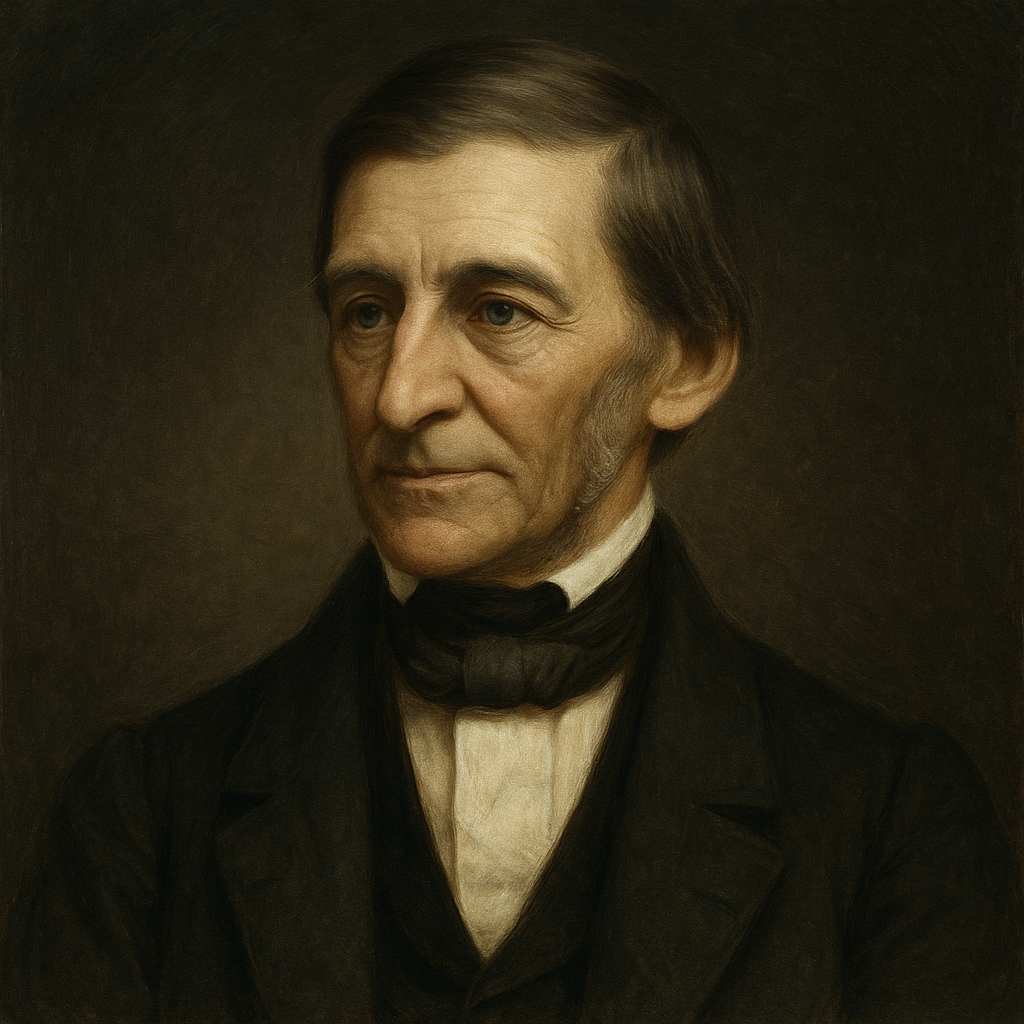The Nun's Aspiration
Ralph Waldo Emerson
1803 to 1882

Want to track your favorites? Reopen or create a unique username. No personal details are required!
The yesterday doth never smile,
The day goes drudging through the while,
Yet, in the name of Godhead, I
The morrow front, and can defy;
Though I am weak, yet God, when prayed,
Cannot withhold his conquering aid.
Ah me! it was my childhood's thought,
If He should make my web a blot
On life's fair picture of delight,
My heart's content would find it right.
But O, these waves and leaves,-
When happy stoic Nature grieves,
No human speech so beautiful
As their murmurs mine to lull.
On this altar God hath built
I lay my vanity and guilt;
Nor me can Hope or Passion urge
Hearing as now the lofty dirge
Which blasts of Northern mountains hymn,
Nature's funeral high and dim,-
Sable pageantry of clouds,
Mourning summer laid in shrouds.
Many a day shall dawn and die,
Many an angel wander by,
And passing, light my sunken turf
Moist perhaps by ocean surf,
Forgotten amid splendid tombs,
Yet wreathed and hid by summer blooms.
On earth I dream;-I die to be:
Time, shake not thy bald head at me.
I challenge thee to hurry past
Or for my turn to fly too fast.
Think me not numbed or halt with age,
Or cares that earth to earth engage,
Caught with love's cord of twisted beams,
Or mired by climate's gross extremes.
I tire of shams, I rush to be:
I pass with yonder comet free,-
Pass with the comet into space
Which mocks thy aeons to embrace;
Aeons which tardily unfold
Realm beyond realm,-extent untold;
No early morn, no evening late,-
Realms self-upheld, disdaining Fate,
Whose shining sons, too great for fame,
Never heard thy weary name;
Nor lives the tragic bard to say
How drear the part I held in one,
How lame the other limped away.
Ralph Waldo Emerson's The Nun's Aspiration
Ralph Waldo Emerson’s The Nun's Aspiration is a profound meditation on the tension between earthly existence and spiritual transcendence, a theme that resonates deeply within the broader context of Emerson’s transcendentalist philosophy. Written in the mid-19th century, a period marked by rapid industrialization, religious skepticism, and a burgeoning interest in individualism, the poem reflects Emerson’s characteristic preoccupation with the soul’s journey and its relationship to the divine. Through its rich imagery, contemplative tone, and philosophical depth, The Nun's Aspiration invites readers to consider the nature of human aspiration, the limitations of temporal life, and the promise of spiritual liberation.
Historical and Cultural Context
To fully appreciate The Nun's Aspiration, it is essential to situate it within the historical and cultural milieu of Emerson’s time. The mid-19th century in America was a period of profound transformation. The Industrial Revolution was reshaping society, bringing with it both technological progress and a sense of alienation from nature. Concurrently, the Second Great Awakening had reignited religious fervor, while transcendentalism emerged as a counter-movement, emphasizing individualism, intuition, and the inherent divinity of the natural world.
Emerson, a central figure in the transcendentalist movement, sought to reconcile the spiritual and the material, the eternal and the temporal. His works often explore the idea that the human soul is a microcosm of the divine, capable of transcending the mundane through introspection and communion with nature. The Nun's Aspiration exemplifies this ethos, presenting the speaker—a nun—as a figure who aspires to rise above the drudgery of daily life and achieve union with the divine.
The poem also reflects the broader 19th-century fascination with monasticism and asceticism, which were often romanticized as paths to spiritual purity. The nun’s voice, however, is not one of passive resignation but of active defiance against the constraints of time and mortality. This aligns with Emerson’s belief in self-reliance and the individual’s capacity to shape their destiny.
Themes and Philosophical Underpinnings
At its core, The Nun's Aspiration grapples with the themes of time, mortality, and spiritual transcendence. The poem opens with a reflection on the relentless passage of time: “The yesterday doth never smile, / The day goes drudging through the while.” These lines evoke a sense of weariness with the cyclical nature of earthly existence, where each day blends into the next without joy or fulfillment. Yet, the speaker finds solace in the promise of the future, declaring, “Yet, in the name of Godhead, I / The morrow front, and can defy.” This defiance is not born of arrogance but of faith in divine assistance: “Though I am weak, yet God, when prayed, / Cannot withhold his conquering aid.”
The poem’s central tension lies in the contrast between the ephemeral and the eternal. The speaker acknowledges the transient nature of human life, symbolized by “waves and leaves” and the “sable pageantry of clouds” mourning the death of summer. Yet, she also envisions a realm beyond time and space, where “realms self-upheld, disdaining Fate” exist in perpetual splendor. This vision of transcendence is both a rejection of earthly limitations and an affirmation of the soul’s immortality.
Another key theme is the rejection of societal expectations and material concerns. The speaker dismisses the “shams” of earthly life, including love, fame, and the pursuit of worldly success. Instead, she aspires to “pass with yonder comet free,” embracing a cosmic perspective that renders human concerns insignificant. This aligns with Emerson’s transcendentalist belief in the primacy of the individual soul over societal conventions.
Literary Devices and Imagery
Emerson’s use of literary devices in The Nun's Aspiration is both sophisticated and evocative, enhancing the poem’s emotional and philosophical impact. The imagery, in particular, is striking, drawing on natural and celestial motifs to convey the poem’s themes. For instance, the “waves and leaves” and the “blasts of Northern mountains” evoke the beauty and power of nature, while the “comet” and “realms beyond realms” suggest the vastness of the cosmos. These images serve to juxtapose the finite with the infinite, highlighting the speaker’s longing for transcendence.
The poem also employs personification to great effect. Time is depicted as a figure with a “bald head,” a symbol of its relentless and indifferent progression. The speaker’s challenge to Time—“I challenge thee to hurry past / Or for my turn to fly too fast”—imbues the abstract concept with a sense of agency, making the struggle against mortality feel immediate and personal.
Emerson’s use of paradox further enriches the poem. The speaker describes herself as both “weak” and capable of defying Time, suggesting that true strength lies in spiritual faith rather than physical power. Similarly, the image of being “forgotten amid splendid tombs” yet “wreathed and hid by summer blooms” underscores the tension between obscurity and eternal significance.
The poem’s tone is contemplative and introspective, yet it also carries an undercurrent of urgency. The speaker’s declaration, “I tire of shams, I rush to be,” conveys a sense of impatience with the superficialities of earthly life and a fervent desire for spiritual liberation. This urgency is tempered by the poem’s meditative rhythm, which mirrors the ebb and flow of the speaker’s thoughts.
Emotional Impact
The Nun's Aspiration resonates on an emotional level by articulating a universal human longing—the desire to transcend the limitations of mortality and achieve a higher state of being. The speaker’s voice is both vulnerable and defiant, capturing the complexity of the human experience. Her acknowledgment of weakness and her reliance on divine aid make her relatable, while her aspiration to “pass with the comet into space” inspires awe and admiration.
The poem’s emotional power is further amplified by its imagery, which evokes a sense of wonder and reverence for the natural world. The “murmurs” of waves and leaves, the “lofty dirge” of the mountains, and the “shining sons” of the eternal realms create a tapestry of sound and vision that immerses the reader in the speaker’s spiritual journey. At the same time, the poem’s acknowledgment of life’s fleetingness—“Many a day shall dawn and die”—lends it a poignant quality, reminding readers of the impermanence that makes transcendence so compelling.
Conclusion
Ralph Waldo Emerson’s The Nun's Aspiration is a masterful exploration of the human spirit’s capacity for transcendence. Through its rich imagery, philosophical depth, and emotional resonance, the poem captures the essence of Emerson’s transcendentalist vision, offering readers a glimpse into the soul’s journey toward the divine. The nun’s voice, at once humble and defiant, serves as a powerful reminder of the enduring human aspiration to rise above the temporal and touch the eternal.
In a world increasingly dominated by material concerns, The Nun's Aspiration remains a timeless testament to the power of faith, imagination, and the indomitable human spirit. It invites us to look beyond the “shams” of earthly life and embrace the boundless possibilities of the soul’s journey. In doing so, it not only reflects the cultural and historical context of Emerson’s time but also speaks to the universal human condition, offering solace and inspiration to readers across generations.
This text was generated by AI and is for reference only. Learn more
Want to join the discussion? Reopen or create a unique username to comment. No personal details required!



Comments
No comments yet. Be the first to comment!